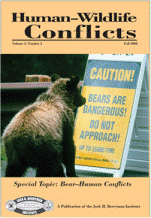Wildlife Damage Management, Internet Center for
Date of this Version
2008
Abstract
Black bears (Ursus americanus) are opportunistic omnivores (Simpson 1945) that feed on grasses, grubs, insects, berries, human garbage, and they scavenge from animal carcasses (Cotton 2008, Thiemann et al. 2008). During the spring, they also girdle trees to feed on the newly forming phloem (Poelker and Hartwell 1973, Noble and Meslow 1998, Partridge et al. 2001). Extensive black bear damage to conifers coincided with the beginning of intensive forest management on industrial and smaller private lands in western Washington during the early 1940s; high-yield tree plantations (i.e., tree farms) required protection to reduce tree girdling by black bears. During the mid-1950s, bear damage occurrence and frequency was recorded on Douglas fir (Pseudotsuga menziesii), western hemlock (Tsuga heterophylla), and western red cedar (Thuja plicata) after bear damage had spread across most of the Pacific Northwest (Lauckhart 1955).


Comments
Published in Human-Wildlife Conflicts Volume 2, Number 2, Pages 153-159, Fall 2008. Published and copyright by Jack H. Berryman Institute. http://www.berrymaninstitute.org/journal/index.html